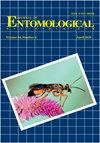Paleothius mckayi sp. n.: A New Species of Staphylininae (Arthropoda: Insecta: Coleoptera: Staphylinidae) from Orapa in Botswana1
IF 0.7
4区 农林科学
Q4 ENTOMOLOGY
引用次数: 0
Abstract
A new species of a staphylinid beetle, Paleothius mckayi sp. n. is described using a single fossil from the Orapa Diamond Mine in Botswana. Paleothius is placed in the extant subfamily Staphylininae based on its general symmetrical habitus, typical sub-limuloid and elongated medium-to-large body form, elongated head, remarkably long antennomere 1, antennal density increasing apically, antennal insertions closer to the eye than to each other, tapering abdomen with two pairs of paratergites, and intersegmental membranes with ‘brick-wall’ pattern. It is separated from its sister clade Paederinae by having exposed antennal insertions and a small post-coxal process. It can be distinguished from all other Staphylininae by its significantly curved temples and large subtriangular pro-, meta- and meso-coxae. The specimen is preserved with flexed, distally-sharpened, extended or protruding scissor-like mouthparts. It is possible that it was primarily using these extended or protruding scissor-like mouthparts to actively hunt prey in leaf litter and other microhabitats in and around the crater lake at Orapa. This fossil further confirms the widespread distribution of staphylinines during the Cretaceous. Moreover, similarly to other previously described fossil staphylinine staphylinid beetles, it portrays morphological stasis, or morphological conservatism. This is also known as arrested evolution. Therefore, it provides evidence for punctuated evolution dating back to the Cretaceous. Moreover, it highlights that morphological similarities between Staphylininae and Paederine date back to the Jurassic period.Paleothius mckayi sp:来自博茨瓦纳 Orapa 的 Staphylininae(节肢动物门:昆虫纲:鞘翅目:Staphylinidae)新种1
本文利用来自博茨瓦纳奥拉帕钻石矿的一块化石描述了一种新的甲壳虫--Paleothius mckayi sp.n.。Paleothius 被归入现生的金龟子亚科(Staphylinae),这是基于其总体对称的习性、典型的近扁球形和拉长的中大型体形、拉长的头部、特别长的第 1触角、触角密度在顶部增加、触角插入点距离眼部比彼此更近、腹部变细且有两对副鳞片以及具有 "砖墙 "图案的节间膜。它与姊妹支系 Paederinae 的区别在于,它的触角插入部位外露,后喙突较小。它与所有其他 Staphylinae 的区别在于其明显弯曲的鬓角和大的近三角形原尾、中尾和中尾。该标本保存有弯曲、上部锐利、延长或突出的剪刀状口器。它可能主要利用这些伸出或突出的剪刀状口器在奥拉帕火山口湖及其周围的落叶层和其他微生境中积极捕食猎物。该化石进一步证实了白垩纪期间石龙子的广泛分布。此外,与之前描述过的其他金眼锹形甲虫化石类似,它也表现出形态停滞或形态保守的特征。这也被称为停滞进化。因此,它为白垩纪的点状进化提供了证据。此外,它还突显了蝶形目与蝶形科在形态上的相似性,这种相似性可以追溯到侏罗纪时期。
本文章由计算机程序翻译,如有差异,请以英文原文为准。
求助全文
约1分钟内获得全文
求助全文
来源期刊
CiteScore
1.20
自引率
11.10%
发文量
40
审稿时长
>12 weeks
期刊介绍:
The Journal of Entomological Science (ISSN 0749-8004) is a peer-reviewed, scholarly journal that is published quarterly (January, April, July, and October) under the auspices of the Georgia Entomological Society in concert with Allen Press (Lawrence, Kansas). Manuscripts deemed acceptable for publication in the Journal report original research with insects and related arthropods or literature reviews offering foundations to innovative directions in entomological research
文献相关原料
| 公司名称 | 产品信息 | 采购帮参考价格 |
|---|

 求助内容:
求助内容: 应助结果提醒方式:
应助结果提醒方式:


